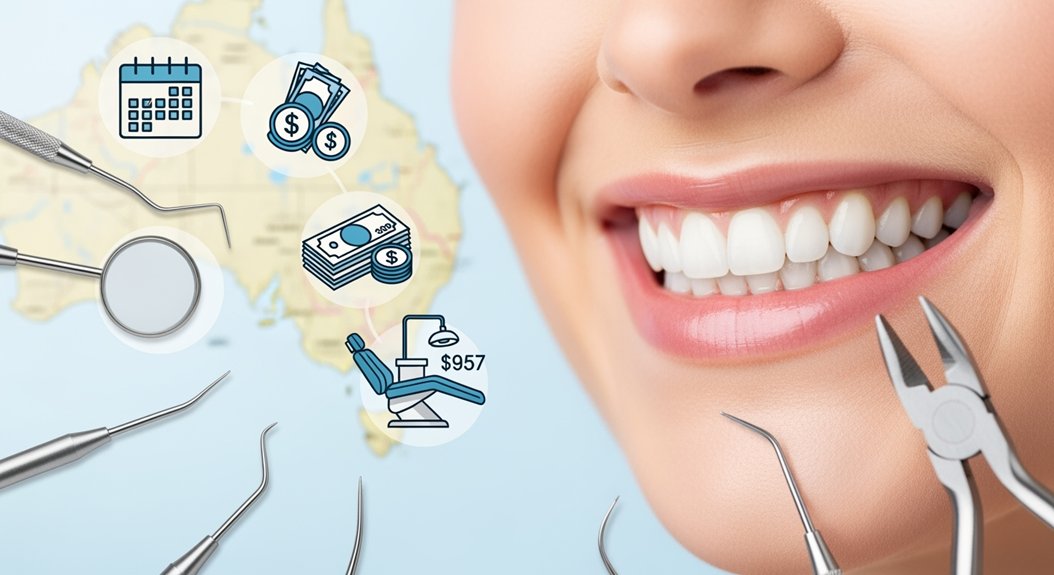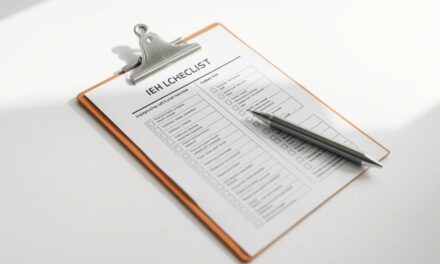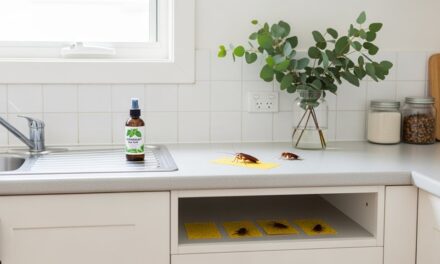Teeth whitening costs in Australia vary considerably due to factors such as dentist expertise, with more experienced practitioners charging premium fees linked to superior techniques and care. Treatment types also influence pricing; in-office procedures range from $600 to $1,200, while take-home kits offer lower-cost options. Geographic location affects fees through clinic operating expenses and available technology. Additionally, teeth condition severity, customization level, and product quality greatly impact overall costs. Further examination reveals how these elements intricately drive pricing structures.
Highlights
- Dentist experience significantly raises teeth whitening costs due to advanced skills, specialized equipment, and personalized post-treatment care.
- In-office procedures cost $600–$1,200 for immediate results, while take-home kits range from $250 to $600 balancing price and customization.
- Custom trays, treatment duration, and teeth condition complexity increase fees by requiring tailored gels, longer oversight, and pre-treatment care.
- Urban clinics charge higher prices reflecting advanced technology, higher operating expenses, and specialized treatments compared to rural or suburban clinics.
- Premium product quality with potent active ingredients and safety testing elevates costs but enhances whitening efficacy and reduces sensitivity.
Dentist’s Experience and Its Effect on Whitening Prices
How does a dentist’s level of experience influence the cost of teeth whitening in Australia?
Data indicate that dentists with extensive experience or specialisation in cosmetic dentistry command higher fees, justified by their advanced skills and superior aesthetic outcomes.
This cost premium reflects not just the use of specialised techniques and equipment but also thorough treatment planning and post-treatment care, which enhance patient satisfaction.
Experienced practitioners reduce risks such as tooth sensitivity and uneven whitening, ensuring longer-lasting, safer results and often employ professional-grade products that contribute to the effectiveness and safety of the treatment.
Expert dentists minimize tooth sensitivity and uneven whitening for safer, more durable results.
In addition, their reputation and personalised care models contribute to higher operating expenses, which are passed on to patients.
Consequently, the elevated cost associated with highly skilled dentists is supported by measurable improvements in treatment efficacy and patient satisfaction, representing a clear case of cost justification within the competitive Australian dental market.
Influence of Treatment Types on Cost Variation
Teeth whitening costs in Australia vary considerably based on treatment type, with in-office procedures priced between $600 and $1,200 due to professional customization and immediate results.
Take-home kits offer a mid-range option at $250 to $400, balancing affordability with custom trays and longer application times.
Over-the-counter products represent the lowest cost bracket, around $20 to $100, but feature lower concentrations of active agents and less consistent outcomes.
The choice of technology, such as LED or UV light used in professional treatments, can also influence the overall price.
In-Office vs. Take-Home
Although both in-office and take-home whitening treatments aim to enhance dental aesthetics, their cost structures diverge considerably due to differences in application methods, professional involvement, and treatment intensity.
In-office whitening typically ranges from $500 to $2000 per session, reflecting the use of stronger gels, advanced technology, and direct dentist supervision. Take-home kits cost between $300 and $600, offering gradual whitening with reduced professional time.
Key distinctions in whitening methods affecting treatment preferences include:
- Speed and efficacy: In-office treatments deliver immediate results versus the slower effect of take-home kits.
- Professional expertise: Higher fees correspond to dentist-led application in clinics.
- Treatment intensity: Concentration of whitening agents varies, influencing safety and cost.
Additionally, prices vary based on the clinic and location in Australia, which contributes to the overall cost differences.
These factors collectively influence patient choices and pricing within Australian dental markets.
Customisation and Duration
When evaluating teeth whitening options, the degree of personalization and treatment duration considerably influence overall costs.
Custom trays, created from precise dental impressions, increase material and labour expenses but enhance treatment efficacy and aesthetics. Customized bleaching gels designed to sensitivity and shade preferences also elevate pricing.
Treatment schedules vary, with longer or multi-session protocols demanding higher fees due to extended clinical oversight and follow-up appointments. Some clinics offer package deals that combine multiple sessions or additional services, which can affect the final cost.
Complex cases requiring combination in-chair and at-home treatments amplify total costs, especially when involving repeated dental assessments or preparatory cleanings.
Clinics in metropolitan areas or those employing experienced cosmetic dentists often charge premiums reflecting these personalized, longer-duration services.
Consequently, the interplay between customized treatment elements and duration drives significant cost variability across providers in Australia’s teeth whitening market.
Over-the-Counter Options
Since over-the-counter (OTC) teeth whitening products encompass a diverse array of treatment types—including gels, strips, trays, and toothpastes—their cost variation is greatly influenced by product format, active ingredient concentration, and brand positioning.
Consumer preferences and product availability further impact pricing dynamics. Key factors include:
- Product Type: Single-use strips or gels ($10–$30) are more affordable, while multi-treatment tray kits ($50–$150) command higher prices due to complexity and volume.
- Active Ingredients: Lower peroxide concentrations guarantee safety but require longer usage, influencing perceived value and repeat purchases. Many OTC products use carbamide peroxide or hydrogen peroxide as the active bleaching agents.
- Brand Positioning: Premium and imported brands set higher price points; private labels offer cost-effective alternatives, reflecting market competition and consumer demand.
How Teeth Condition Affects Whitening Expenses
Because the condition of teeth directly influences the complexity and frequency of whitening treatments, it greatly impacts overall costs in Australia’s dental industry.
Severity of teeth discoloration dictates treatment intensity; mild to moderate staining requires fewer sessions, while severe intrinsic stains or age-related yellowing demand multiple, costly whitening treatments.
Additionally, dental restorations such as crowns or veneers do not respond to bleaching, often necessitating replacement to match whitened teeth, adding to expenses.
Enamel erosion, sensitivity, and underlying oral health issues further complicate procedures, requiring pre-treatment care and specialized products. An initial consultation assesses teeth and gums to determine the most suitable whitening method.
Baseline tooth shade and desired whitening levels also influence cost, with dramatic changes necessitating advanced, higher-priced methods.
Consequently, individualized assessment of teeth condition is essential for accurate cost estimation in whitening procedures.
Geographic Location and Its Role in Pricing
Teeth whitening costs in Australia exhibit significant variation between urban and rural areas, driven largely by differences in clinic operating expenses such as rent and wages.
Major metropolitan centers typically command higher prices due to elevated local economic factors, including cost of living and consumer spending power.
These regional disparities influence both the availability of specialized services and pricing strategies across the market. Additionally, consulting a dentist in the specific area, such as the Sunshine Coast, is advisable to determine the best whitening options and accurate pricing based on geographic location.
Urban Vs Rural Costs
Although teeth whitening services are available across Australia, geographic location greatly influences their pricing structures. Urban clinics typically charge higher prices driven by advanced technology, specialized treatments, and elevated operating costs.
Conversely, rural clinics often offer lower prices due to reduced expenses but may provide fewer specialized options.
Key factors affecting urban vs rural cost comparison include:
- Urban centers provide more advanced in-chair whitening with faster, customized treatments, increasing costs.
- Rural clinics focus on basic services and take-home kits, reflecting simpler, less costly options.
- Patient preferences for convenience and perceived quality in urban clinics can justify premium pricing despite alternatives.
Additionally, the type of whitening treatment used in a clinic significantly impacts the overall cost, with professional in-chair procedures generally costing more than at-home kits.
This geographic cost divergence highlights the importance of location in teeth whitening pricing strategies across Australia’s dental industry.
Clinic Operating Expenses
Clinic operating expenses constitute a critical determinant in the pricing structures of teeth whitening services across Australia, with geographic location playing a pivotal role.
Clinics situated in urban centers face elevated rent, utility, and staffing costs, directly increasing clinic expenses and resulting in higher consumer prices. Conversely, suburban clinics typically benefit from lower overheads, enabling more competitive pricing.
Operational efficiency also influences costs; clinics optimizing layout, technology, and staff training can mitigate expenses despite geographic challenges. For example, adhering to ADA guidelines and WHS standards ensures compliance while enhancing clinic workflow and patient safety.
Additionally, compliance with varying local health regulations affects costs, as does the competitive landscape within each region.
As a result, geographic location shapes not just fixed expenses but also the scope for operational efficiency, collectively impacting teeth whitening pricing strategies across Australia’s diverse clinic environments.
Regional Economic Influence
Geographic location considerably shapes the economic factors influencing teeth whitening pricing across Australia. Regional price disparities primarily arise from variations in operational costs, cost of living, and market demand.
Urban centers such as Sydney and Melbourne exhibit higher prices due to elevated expenses and greater dental competition. Conversely, rural areas demonstrate lower pricing but limited service access. The availability of professional guidance also varies by location, which can affect pricing and treatment quality.
Key factors impacting regional price include:
- Urban vs. rural economic conditions influencing operational costs and demand.
- Socioeconomic demographics driving willingness to pay and service availability.
- Density of dental clinics affecting dental competition and pricing strategies.
Consequently, teeth whitening costs fluctuate greatly across regions, reflecting localized economic dynamics and competitive landscapes within Australia’s dental service market.
The Impact of Product Quality on Whitening Costs
Because product quality directly influences both efficacy and safety, it greatly affects the overall cost of teeth whitening treatments. Higher-quality products typically use potent active ingredients like hydrogen peroxide at elevated concentrations, enhancing product efficacy and accelerating results. These premium formulations undergo rigorous safety testing and comply with regulatory standards, increasing production costs. Brand loyalty plays a significant role as consumers often prefer reputable dental brands backed by clinical evidence and patented technology, justifying higher prices. Additionally, superior products reduce tooth sensitivity and provide longer-lasting whitening effects, resulting in fewer repeat treatments and enhanced value. The exclusivity of distribution through select dental practices further elevates costs. Professional teeth whitening also involves in-office treatments, which tend to cost more than take-home kits due to the controlled environment and expert administration. Consequently, product quality remains a critical determinant of whitening expenses, reflecting investment in research, safety protocols, and sustained clinical performance.
Comparing In-Chair Whitening to Take-Home Kits
While in-chair whitening offers immediate aesthetic improvements through high-concentration bleaching agents and advanced technologies such as laser or LED, it typically incurs higher costs ranging from $450 to $2,000 per session. This method involves applying a strong whitening gel activated by light for about 90 minutes, providing instant but sometimes short-lived results due to tooth dehydration.
In contrast, take-home kits provide a cost-effective alternative priced between $250 and $600, with custom-fitted trays enhancing whitening benefits over a longer treatment duration. These trays, made from impressions of your teeth, allow for a custom-fit application that prevents gum irritation and supports the use of stronger gel concentrations.
Treatment preferences vary based on urgency, budget, and convenience.
Key distinctions include:
- In-chair whitening delivers rapid results but may require frequent maintenance.
- Take-home kits offer gradual, longer-lasting effects with flexible application.
- Sensitivity and cost considerations often guide patient selection.
This comparison underscores the balance between immediate efficacy and sustained outcomes influencing whitening treatment preferences in Australia’s dental market.
Urban Versus Rural Clinic Pricing Differences
Teeth whitening costs in urban Australian clinics are typically higher due to increased operational expenses, advanced technology investments, and greater specialist availability.
In contrast, rural clinics generally offer lower prices, reflecting reduced overheads and less access to cutting-edge equipment.
These geographic disparities considerably influence patient expenditure on cosmetic dental services nationwide.
Professional treatments like Zoom Whitening, BOOST, and Kor Whitening, which last about 30 minutes, are examples of professional treatments that may vary in availability depending on location.
Urban Clinic Pricing
Although urban dental clinics often face higher operating expenses and a greater cost of living, these factors contribute significantly to elevated teeth whitening prices compared to rural areas.
Urban clinics typically combine advanced technology, specialized treatments, and highly experienced dentists, influencing overall costs. Competitive pricing emerges from dense market competition yet is tempered by high demand and premium service offerings.
Key factors impacting urban clinic pricing include:
- Advanced Treatment Options – Access to specialized, multi-session whitening procedures raises fees.
- Dentist Expertise – Urban clinics employ highly trained professionals commanding higher rates.
- Bundled Services – Additional offerings such as cleanings or consultations often increase total costs.
Additionally, understanding the value in oral health helps patients appreciate the investment in quality dental care provided by urban clinics.
Thus, urban clinic pricing reflects a balance between operational costs, service quality, and market-driven competitive dynamics.
Rural Treatment Costs
Significant pricing disparities exist between rural and urban dental clinics for professional whitening treatments, with rural clinics generally offering services at 10-30% lower costs. This trend is influenced by lower overheads, reduced demand, and sometimes limited access to advanced whitening technologies. Rural practitioners typically have broad general dental expertise but may possess less specialized cosmetic skills, impacting both pricing and treatment quality. Additionally, rural clinics often provide simpler treatment protocols or use mid-range products to manage costs. Professional whitening ensures tailored approaches and safety, which may be less accessible in some rural settings.
| Factor | Rural Clinics |
|---|---|
| Pricing Difference | 10-30% lower than urban clinics |
| Whitening Technology | Limited access to advanced options |
| Practitioner Expertise | Broad skills, fewer cosmetic specialists |
| Treatment Sessions | Fewer or simpler sessions |
| Product Quality | Standard or mid-range products |
Role of Advanced Technology in Teeth Whitening Costs
Advanced technology frequently plays a pivotal role in determining the cost structure of teeth whitening treatments in Australia. The integration of advanced techniques and technology innovations, such as LED lights and laser systems, greatly influences pricing.
Three primary factors contribute to this impact:
- Equipment Sophistication: High-end technologies like laser whitening, costing between $800 and $2,000, deliver faster, more effective results but increase treatment expenses.
- Expertise and Training: Specialized training required for operating advanced devices elevates professional fees, reflecting the skill involved.
- Market Positioning: Clinics equipped with cutting-edge technology can justify premium pricing by offering enhanced safety, comfort, and consistent outcomes.
Additionally, professional treatments often provide immediate and visible improvements, distinguishing them from longer-duration home kits and justifying a higher cost due to the effectiveness of delivery.
These elements collectively underscore how advancements in whitening technology shape cost variability and patient experience in the Australian dental market.
Effect of Heavy Stains Versus Light Stains on Treatment Cost
The degree of tooth discoloration directly influences the complexity and cost structure of whitening treatments in Australia. Heavy stains require multiple sessions, stronger bleaching agents, and often specialist referral, greatly increasing costs. Light stains typically need fewer sessions and standard products, resulting in lower expenses. Treatment plans for heavy stains may include premium technologies or additional procedures like microabrasion, while light stains respond well to basic kits or single in-chair treatments. Professional treatments administered by dentists or dental hygienists generally provide longer-lasting results, which is an important consideration when dealing with professional whitening.
| Aspect | Heavy Stains | Light Stains |
|---|---|---|
| Sessions Required | Multiple, extended duration | Usually single session |
| Product Strength | High concentration, advanced gels | Standard concentration gels |
| Cost Impact | Higher due to complexity and referrals | Lower, standard pricing |
This stratification highlights how stain severity drives whitening costs.
How Customisation and Treatment Duration Influence Price
Although teeth whitening treatments share a common goal, variations in customisation and treatment duration greatly influence pricing structures across Australian clinics.
Custom trays greatly affect cost by providing improved fit, reducing gum irritation, and enhancing treatment effectiveness, with personalised kits priced between $250–$600 versus $20–$150 for non-custom over-the-counter options. These custom-fitted trays include professional-grade whitening gel, which contributes to more consistent and longer-lasting results compared to store-bought products.
Treatment duration also impacts price:
- In-chair whitening sessions last 60–90 minutes, costing $600–$1,000 due to professional supervision and immediate results.
- Take-home kits require 1–2 weeks of daily use, balancing lower per-session costs against extended timelines. These kits often come with flexible usage instructions that allow patients to whiten at their convenience.
- Over-the-counter products offer shorter treatments and lower costs but diminished effectiveness.
Higher customisation increases clinic overhead, while longer durations influence labour and materials, collectively driving price variability. Additionally, in-chair treatments use medical-grade hydrogen peroxide gels and curing lights, which justify their premium pricing due to the effectiveness and safety ensured by professional application.
Frequently Asked Questions
Are Teeth Whitening Results Permanent or Will I Need Repeat Treatments?
Teeth whitening results are not permanent; whitening longevity varies based on treatment type and individual factors. Consistent maintenance routines, including proper oral hygiene and periodic touch-ups, are essential to sustain results and delay the need for repeat treatments.
Can Teeth Whitening Cause Tooth Sensitivity or Damage Enamel?
Tooth sensitivity frequently occurs due to bleaching agents temporarily exposing dentin, with higher peroxide concentrations increasing risk. Enamel damage is minimal and reversible when treatments follow professional protocols, though compromised enamel may heighten sensitivity and potential harm.
Are There Any Age Restrictions for Teeth Whitening Treatments?
Age limitations and legal regulations in Australia restrict teeth whitening to individuals typically aged 16 or older, with many clinics enforcing 18 as minimum, ensuring enamel maturity and safety while complying with industry standards and health guidelines.
How Long Does a Typical Teeth Whitening Session Last?
Typical teeth whitening session duration ranges from 45 to 90 minutes, influenced by treatment type and individual needs. Treatment frequency varies, with multiple sessions required for severe discoloration, optimizing cumulative effectiveness and patient outcomes in clinical practice.
Is Teeth Whitening Safe During Pregnancy or Breastfeeding?
Pregnancy safety concerns lead most dentists to recommend postponing teeth whitening due to limited data and potential irritation. Breastfeeding considerations indicate low risk with non-toxic, low-peroxide products, though professional consultation remains essential for informed decisions.










